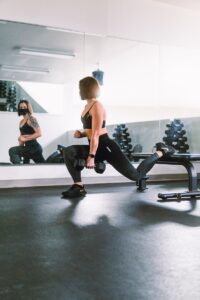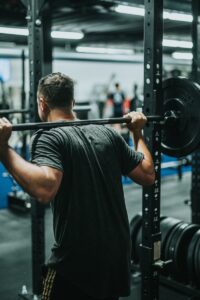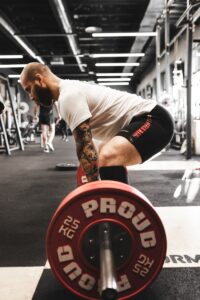Squats are an essential exercise that improves our lower body strength, bone density, and metabolism. They are known to stimulate muscle growth, improve our posture, and burn significant amounts of calories. Squats are a highly beneficial exercise for people of all age groups and fitness levels. However, they are also an exercise that is commonly done incorrectly, which can cause injury or simply ineffective results. In this article, I’ll be discussing how to do squats correctly, the benefits of squats, and how you can incorporate them into your routine to achieve your fitness goals.
Squats engage several major muscle groups like the quadriceps, hamstrings, glutes, hips and core. This makes them an extremely efficient exercise for building overall strength. The key muscles worked in the squat are the quadriceps and glutes. As you lower into the squat, your quadriceps eccentrically contract to control the motion. As you drive back up, the quadriceps concentrically contract. The glutes are heavily involved as hip extensors to initiate the upward motion. The core muscles are isometrically contracted to maintain a neutral, upright torso position. This full-body exercise recruits these major muscle groups through their complete range of motion for an excellent strength-building stimulus.
Properly performing squats requires technique, mobility, stability and practice. Mastering the movement pattern takes time, but is well worth the effort considering how effective squats are for muscle growth, weight loss, athleticism, and more. Follow along as I break down proper squat form step-by-step and provide tips for getting the most out of this exercise.
 How to Do Squats
How to Do Squats
Squats can be done using several variations such as weighted squats, bodyweight squats, and single-leg squats. Here’s how to do a basic bodyweight squat properly:
- Stand with your feet shoulder-width apart, toes pointing forward. Engage your core.
- Inhale and initiate the movement by sending your hips back while allowing your knees to bend. Sit back like you’re lowering into a chair. Keep your chest up, back straight and eyes forward.
- Descend until your thighs are at least parallel to the floor. Go lower if you can while maintaining form.
- Drive through your heels to stand back up to the starting position, fully extending your hips and knees. Exhale at the top.
- Repeat for the desired number of reps, keeping your movements slow and controlled.
Focus on proper form rather than speed. Sit back into the squat rather than allowing your knees to push forward over your toes. Keep your torso upright and maintain an athletic stance throughout the set.
Common Mistakes to Avoid
It’s essential to perform squats using the correct form to avoid any injuries or wasted efforts. Here are some common mistakes to steer clear of:
- Collapsing knees inward instead of pushing them outward to track over your toes. Keep knees in line with your toes.
- Rounding your lower back instead of keeping your torso upright. Maintain a neutral spine by engaging your core.
- Lifting your heels off the floor or leaning forward onto your toes. Pressure should stay in your heels.
- Failing to drop your hips straight down versus pushing your hips back behind you. Initiate the movement by sending your butt back while keeping your torso upright.
- Not going deep enough. Hit at least parallel with your thighs to get maximum muscle activation. Go deeper as your mobility allows.
Avoid these form errors, and you’ll get optimal results from squats while protecting your joints. Film yourself to check for mistakes. Consider hiring a trainer if unsure about your technique. Mastering proper form is crucial.
 Squat Variations to Try
Squat Variations to Try
While traditional bodyweight squats are excellent, there are many squat variations that offer unique benefits. Mixing up your squat type keeps things interesting while working your muscles in new ways. Here are some popular squat varieties:
- Barbell Back Squat: Holding a barbell across your upper back adds challenge and helps build full-body strength for athletes.
- Dumbbell Goblet Squat: Holding a dumbbell at your chest targets core stability since you can’t rest the load on your back.
- Bulgarian Split Squat: Performed with one leg elevated, these build single leg strength and balance.
- Box Squat: Sitting back onto a box teaches you to properly use your hip hinge pattern.
- Jump Squat: Explosively jumping at the top turns squats into a plyometric move for power.
- Front Squat: Holding the barbell in front challenges your mobility and engages your upper back.
Test out new squat versions to target different weaknesses, avoid plateaus and beat boredom. Proper form remains key regardless of the variation.
Benefits of Squats
As a full body exercise, squats offer numerous benefits beyond building strong legs. Here are some of the top reasons to make squats a staple exercise:
- Increased muscle mass and strength throughout your lower body – Improved athletic performance in terms of speed, jumping and agility
- Enhanced mobility through increased range of motion of the hips, knees and ankles
- Better posture from strengthening the muscles that support your spine and pelvis
- Additional calorie burn and elevated metabolism from activating large muscle groups
- Reduced lower body injury risk by stabilizing joints and connective tissues
- Higher bone mineral density reducing the chance of osteoporosis and fractures
- Improved functional strength for daily activities like getting up from a chair
 Programming Recommendations
Programming Recommendations
Now that you know how to perform squats and their multitude of benefits, how do you program them into your training? Here are some tips:
- Do 2-4 sets of 6-12 reps per session depending on your goals. Heavier weights and lower reps build strength. Lighter loads and higher reps develop muscle size.
- Rest 1-2 minutes between sets to allow full recovery for your next quality set.
- Train squats at least twice per week for optimal progression over time. More frequency is fine for most exercisers.
- Slowly increase weight over time to offer your body new challenges as your get stronger.
- Combine squats with exercises like lunges and leg presses for a complete lower body routine.
- Use squat variations periodically to prevent accommodation and target weak points.
Adding squats into your program just 2-3 times per week can deliver outstanding results if you use proper form and progression. Let squats help elevate your training to new levels!
Conclusion
The squat is an incredibly effective strength training exercise that offers a wide variety of benefits for all populations when performed correctly. By mastering proper squat form, progressively overloading the movement, and programming it frequently, squats can transform your lower body musculature and athletic capacities.
This functional exercise develops the muscle coordination, mobility and stability required for daily life and sports performance. The squat motion is essential for picking items off the floor, getting up from a chair, jumping and changing direction. By rehearsing the motor patterns frequently under load, your nervous system will learn to squat safely and efficiently.
Be sure to master proper squat form outlined in this article before increasing the load and volume. Filming your sets is useful for correcting errors. The most common mistakes include collapsing the knees inward, rounding the lower back, leaning forward onto the toes, and failing to descend fully to activate all the leg musculature. Avoiding these form breaks reduces injury risk.
Take the time to build your squat gradually with perfect technique. It may seem challenging at first, but the exceptional benefits are worth the effort. Make squats a regular part of your routine. Use weight that allows you to complete the desired number of quality reps each set. Increase the load progressively over time as your body adapts. By smartly applying the training principles and exercise science, your squat has unlimited potential.
Let squats become your new exercise obsession. Allow them to transform the shape of your legs and glutes. Harness their performance and health enhancing powers. Squats deserve their reputation as the “king of exercises” because no other single movement provides more functional improvements. They warrant inclusion in all exercise programs due to their versatility, safety and outstanding results. Stop neglecting your legs and get squatting your way fitter, stronger and healthier today!
Leave a Reply